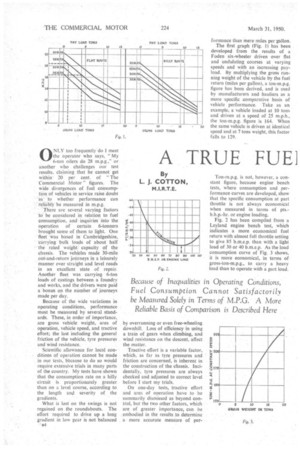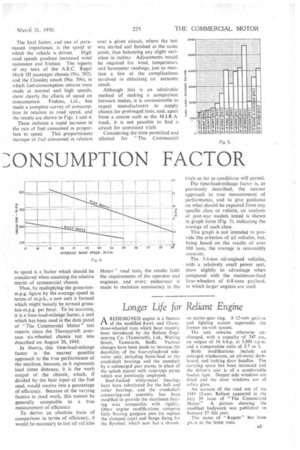A TRUE FUE1 1:0NSUMPTION FACTOR
Page 38

Page 39

If you've noticed an error in this article please click here to report it so we can fix it.
ONLY too frequently do 1 meet the operator who says, "My 6-ton oilers do 28 m.p.g.," or another who challenges our test results. claiming that he cannot get within 20 per cent. of 'The Commercial Motor" figures. The wide divergences of fuel consumpticin of vehicles in service raise doubt as to whether performance can reliably be measured in m.p.g.
There are several varying factors to be considered in relation to fuel consumption, and inquiries into the operation of certain 6-tonners brought some of them to light. One fleet Was based in Cambridgeshire, • carrying bulk loads of about half • the rated weight capacity of the chassis. The vehicles made 30-mile out-and-return journeys in a leisurely manner over straight and level roads in an excellent state of repair. Another fleet was carrying 6-ton loads of castings between a foundry and works, and the drivers were paid a bonus on the number of journeys made per day.
Because of the wide variations in operating conditions, performance must be measured by several standards. These, in order of importance, are gross vehicle weight, area of operation, vehicle speed, and tractive effort; the last including the general friction of the vehicle, tyre pressures and wind resistance.
Scientific allowance for local con . ditions of operation cannot be made in our tests, because to do so would require extensive trials in many parts of the country. My tests have shown that the consumption rate on a hilly circuit is proportionately greater than on a level course, according to the length and severity of the gradients.
What is lost on the swings is not regained on the roundabouts. The effort required to drive up a long gradient in low gear is not balanced 'a.4 by overrunning or even free-wheeling downhill. Loss of efficiency in using a train of gears when climbing, and wind resistance on the descent, affect the matter.
Tractive effort is a variable factor, which, as far as tyre pressures and friction are concerned, is inherent in the construction of the chassis. Incidentally, tyre pressures are always checked and adjusted to correct level before I start my trials.
On one-day tests, tractive effort and area of operation have to be summarily dismissed as beyond control, but the two other factors, which are of greater importance, can be ,embodied in the results to determine a • more accurate measure of per
fortnance than mere miles per gallon.
The first graph (Fig. 1) has been developed from the results of a Foden six-wheeler driven over flat and undulating courses at varying speeds and with an increasing payload. By multiplying the gross rtmning weight of the vehicle by the fuel return (miles per gallon), a ton-m.p.g. figure has been derived, and is used by manufacturers and hauliers as a more specific comparative basis of vehicle performance. Take as an example, a vehicle loaded at 10 tons and driven at a speed of 25 m.p.h., the ton-m.p.g. figure is 164. When the same vehicle is driven at identical speed and at 7 tons weight, this factor falls to 129.
Ton-mpg. is not, however, a constant figure, because engine bench tests, where consumption and performance curves are developed, show that the specific consumption at part throttle is not always economical when measured in terms of pts.b.h.p.-hr. or engine loading.
Fig. 2 has been compiled from a Leyland engine bench test, which indicates a more economical fuel return with almost full throttle setting to give 85 b.m.e.p. than with a light load of 30 or 40 b.m.e.p. As the load consumption curve of Fig. 3 shows, it is more economical, in terms of gross-ton-m.p.g., to carry a heavy load than to operate with a part load. The final factor, and One of paramount importance, is the speed at which the vehicle is driven. High road speeds produce increased wind resistance and friction The reports of my tests of the A.E.C. Regal Mark III passenger chassis (No. 392), and the Crossley coach (No. 396), in which fuel-consumption returns were made at normal and high speeds, show clearly the effects of speed on consumption. Fodens, Ltd., has made a complete survey of consumption in relation to road speed, and the results arc shown in Figs. I and 4.
These indicate a rapid increase in the rate of fuel consumed in propor tion to speed. This proportionate increase of fuel consumed in relation
to speed is a factor which should be considered when assessing the relative merits of commercial chassis.
Thus, by multiplying the gross-tonm.p.g. figure by the average speed in terms of m.p.h., a new unit is formed which might loosely be termed grosston-m.p.g per hour. To be accurate, it is a time-load-mileage factor, a unit which has been used in the data panel of "The Commercial Motor" test reports since the Thornycroft overseas six-wheeled chassis test was described on August 26, 1949.
In theory, this time-load-mileage factor is the nearest possible approach to the true performance of the machine, because, as it represents load times distance, it is the work output of the chassis, which, if divided by the heat input of the fuel used, would resolve into a percentage of efficiency. Because of the varying factors in road work, this cannot be generally acceptable as a true measurement of efficiency.
To derive an absolute basis of comparison in terms of efficiency, it would be necessary to test all vehicles
over a given circuit, where the test was started and finished at the same point, thus balancing any slight variation in incline Adjustments would be required for wind, temperature and barometer readings, just to mention a few of the complications involved in obtaining an accurate result.
Although this is an admirable method of making a comparison between makes, it is unreasonable to expect manufacturers to supply chassis for prolonged tests, and, apart from a course such as the MIRA, track, it is not possible to find a circuit for consistent trials.
Considering the time permitted and allotted for "The Commercial
Motor " road tests, the results fulfil the requirements of the operator and engineer, and every endeavour is made to maintain consistency in the
trials as far as conditions will permit.
The time-load-mileage factor is as previously described, the nearest approach to true measurement of performance, and to give guidance on what should be expected from any specific class of vehicle, an analysis of post-war models tested is shown in graph form (Fig. 5), indicating the average of each class.
This graph is not intended to provide the criterion of all vehicles, but, being based on the results of over 100 tests, the average is reasonably accurate.
The 5-6-ton oil-engined vehicles, with a relatively small power unit, show slightly to advantage when compared with the maximum-load four-wheelers of 6-8-tons payload. in which larger engines are used.




























































































